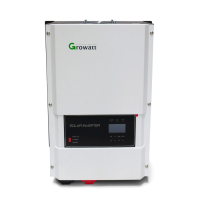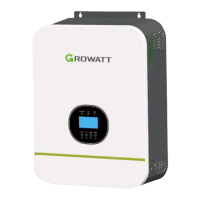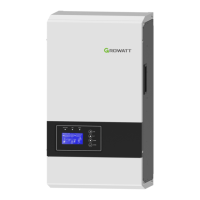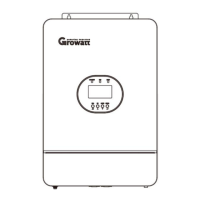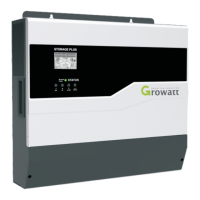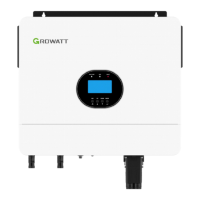Do you have a question about the Growatt SPF3000TL HVM and is the answer not in the manual?
Logic diagram illustrating the SPF off-grid inverter's internal components and connections for system understanding.
Fault description for a locked fan, analysis of causes, and troubleshooting suggestions for fan issues.
Addresses over-temperature faults, NTC cable issues, and environmental factors affecting heat dissipation.
Explains battery overcharging due to voltage, connection issues, or high battery voltage.
Covers low battery warnings, communication protocols with lithium batteries, and low voltage states.
Details overload faults, high output load, inductive loads, and short circuits.
Explains power derating due to low AC input voltage and how to manage load.
Addresses solar charger stoppage caused by incorrect PV panel configuration or high PV voltage.
Discusses solar charger stoppage due to excessive AC output load exceeding inverter capacity.
Covers issues with parallel grid connections and phase differences in three-phase systems.
Addresses phase errors in parallel grid connections, emphasizing correct wiring.
Explains phase loss in parallel output configurations and correct wiring practices.
Details BMS communication errors, protocol differences, and software/firmware upgrades.
Focuses on loss of communication between the inverter and the Battery Management System (BMS).
Addresses cell over-voltage issues, checking PV configuration, and battery specifications.
Covers cell under-voltage issues, checking load capacity, and special load requirements.
Explains total over-voltage conditions, PV configuration, and battery suitability.
Addresses total under-voltage conditions, checking load capacity, and disconnecting loads.
Details discharge over-current faults and checking load capacity against battery limits.
Covers charge over-current issues, PV configuration, and battery charging specifications.
Explains discharge over-temperature faults and checking load capacity against battery limits.
Addresses charge over-temperature issues, PV configuration, and battery charging specifications.
Covers battery over-temperature faults, PV configuration, and battery suitability.
Explains battery under-temperature faults and checking battery suitability for site conditions.
Addresses system shutdown events, checking battery SOC and voltage against program settings.
Fault description for a locked fan, analysis of causes, and troubleshooting suggestions for fan issues.
Fault description for over-temperature, analysis of NTC cable and environment, and suggestions.
Fault description for high battery voltage, analysis of voltage and connection, and suggestions.
Fault description for low battery voltage/soc, analysis of communication and voltage, and suggestions.
Fault description for output short circuit detected by internal components, and suggestions.
Fault description for high output voltage, analysis, and suggestions for clearing the error.
Fault description for overload time out, analysis of load and inductive loads, and suggestions.
Fault description for high bus voltage, analysis, and suggestions for settings and upgrades.
Fault description for bus soft start failure, analysis of settings and component damage, and suggestions.
Fault description for over current or surge, analysis of load and circuit damage, and suggestions.
Fault description for low bus voltage, analysis of load startup, and suggestions for managing loads.
Fault description for inverter soft start failure, analysis of MPPT voltage and components, and suggestions.
Fault description for over DC voltage in AC output, analysis of unbalanced voltage, and suggestions.
Fault description for open battery connection, analysis of communication and battery status, and suggestions.
Fault description for low output voltage, analysis, and suggestions for load management.
Fault description for negative power fault, analysis of wiring and phase difference, and suggestions.
Fault description for CAN fault, analysis of communication cable connection, and suggestions.
Fault description for host loss in three-phase systems, and suggestions for startup sequence.
Fault description for BMS communication error, analysis of protocols and software, and suggestions.
Logic diagram illustrating the SPF off-grid inverter's internal components and connections for system understanding.
Fault description for a locked fan, analysis of causes, and troubleshooting suggestions for fan issues.
Addresses over-temperature faults, NTC cable issues, and environmental factors affecting heat dissipation.
Explains battery overcharging due to voltage, connection issues, or high battery voltage.
Covers low battery warnings, communication protocols with lithium batteries, and low voltage states.
Details overload faults, high output load, inductive loads, and short circuits.
Explains power derating due to low AC input voltage and how to manage load.
Addresses solar charger stoppage caused by incorrect PV panel configuration or high PV voltage.
Discusses solar charger stoppage due to excessive AC output load exceeding inverter capacity.
Covers issues with parallel grid connections and phase differences in three-phase systems.
Addresses phase errors in parallel grid connections, emphasizing correct wiring.
Explains phase loss in parallel output configurations and correct wiring practices.
Details BMS communication errors, protocol differences, and software/firmware upgrades.
Focuses on loss of communication between the inverter and the Battery Management System (BMS).
Addresses cell over-voltage issues, checking PV configuration, and battery specifications.
Covers cell under-voltage issues, checking load capacity, and special load requirements.
Explains total over-voltage conditions, PV configuration, and battery suitability.
Addresses total under-voltage conditions, checking load capacity, and disconnecting loads.
Details discharge over-current faults and checking load capacity against battery limits.
Covers charge over-current issues, PV configuration, and battery charging specifications.
Explains discharge over-temperature faults and checking load capacity against battery limits.
Addresses charge over-temperature issues, PV configuration, and battery charging specifications.
Covers battery over-temperature faults, PV configuration, and battery suitability.
Explains battery under-temperature faults and checking battery suitability for site conditions.
Addresses system shutdown events, checking battery SOC and voltage against program settings.
Fault description for a locked fan, analysis of causes, and troubleshooting suggestions for fan issues.
Fault description for over-temperature, analysis of NTC cable and environment, and suggestions.
Fault description for high battery voltage, analysis of voltage and connection, and suggestions.
Fault description for low battery voltage/soc, analysis of communication and voltage, and suggestions.
Fault description for output short circuit detected by internal components, and suggestions.
Fault description for high output voltage, analysis, and suggestions for clearing the error.
Fault description for overload time out, analysis of load and inductive loads, and suggestions.
Fault description for high bus voltage, analysis, and suggestions for settings and upgrades.
Fault description for bus soft start failure, analysis of settings and component damage, and suggestions.
Fault description for over current or surge, analysis of load and circuit damage, and suggestions.
Fault description for low bus voltage, analysis of load startup, and suggestions for managing loads.
Fault description for inverter soft start failure, analysis of MPPT voltage and components, and suggestions.
Fault description for over DC voltage in AC output, analysis of unbalanced voltage, and suggestions.
Fault description for open battery connection, analysis of communication and battery status, and suggestions.
Fault description for low output voltage, analysis, and suggestions for load management.
Fault description for negative power fault, analysis of wiring and phase difference, and suggestions.
Fault description for CAN fault, analysis of communication cable connection, and suggestions.
Fault description for host loss in three-phase systems, and suggestions for startup sequence.
Fault description for BMS communication error, analysis of protocols and software, and suggestions.
The Growatt SPF3000TL HVM and SPF5000TL HVM models are off-grid inverters designed to power common household appliances, including inductive loads like lights and refrigerators. These inverters can also integrate with diesel generators and the power grid to compensate for insufficient solar energy and to charge the battery.
The inverter operates as a hybrid power system, drawing energy from solar panels, a battery bank, and optionally from a utility grid or generator. The core logic involves an EMI filter for AC input, a DC/DC converter with MPPT (Maximum Power Point Tracking) for solar input, a BUS for internal power distribution, and a DC/AC inverter for AC output. Relays (SFTL, OPL, SFTN) manage the power flow and switching between different sources. The main board controls these components, ensuring efficient power conversion and distribution to the loads.
The inverter is designed for off-grid applications, providing a reliable power supply for homes. It supports various power sources and can charge batteries from solar, grid, or generator input. The system is monitored via a WiFi/GPRS module, allowing users to access information through a monitoring web interface or a dedicated mobile application.
When operating, the inverter displays error and warning messages on its LCD screen. Error codes indicate critical faults that stop power generation, accompanied by a solid red LED. Warning messages, on the other hand, indicate less severe issues, allowing the inverter to continue operating while a red LED flashes. This distinction helps users quickly identify the severity of a problem.
For optimal performance, it's crucial to ensure correct PV panel configuration. For instance, the SPF5000TL HVM model suggests connecting 3 panels in series and 4 in parallel (using 330W panels), ensuring the PV open circuit voltage remains below 145V. Proper battery selection and connection are also vital, with specific communication protocols for lithium-ion batteries like Dyness and Pylon. The inverter supports different battery types, and incorrect settings can lead to communication errors or improper charging.
The inverter includes protection mechanisms against various issues such as fan lock, over-temperature, battery over/under-charge, low battery voltage, overload, and high/low output voltage. In cases of overload, especially with inductive loads, it's recommended to reduce the connected load or restart the inverter to prevent excessive shock current.
For parallel systems, careful wiring of AC input/output cables and communication lines is essential to ensure all inverters operate in sync and maintain proper phase alignment. The neutral lines of all inverters should be connected together, and phase inverters (P1, P2, P3) should connect to their respective lines (L1, L2, L3).
Maintenance primarily involves monitoring the inverter's status via the LCD and addressing any displayed error or warning messages.
In all cases where troubleshooting steps do not resolve the issue, users are advised to contact Growatt Service, providing detailed information about the inverter, the error/warning message, and the problem description. If a replacement is needed, the unit should be shipped in its original box.
| Rated Power | 3000W |
|---|---|
| Input Voltage | 230V AC |
| Output Voltage | 230V AC |
| Efficiency | 93% |
| Dimensions | 330 x 485 x 135 mm |
| Weight | 12 kg |
| Max. PV Array Power | 4000W |
| Max. Charging Current | 60A |
| Max. AC Charging Current | 30A |
| Max. Solar Charging Current | 60A |
| Number of MPP Trackers | 1 |
| Output Frequency | 50/60Hz |
| Communication | RS232 |


